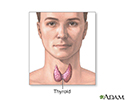Thyroid ultrasound
Ultrasound - thyroid; Thyroid sonogram; Thyroid echogram; Thyroid nodule - ultrasound; Goiter - ultrasoundA thyroid ultrasound is an imaging method to see the thyroid, a gland in the neck that regulates metabolism (the many processes that control the rate of activity in cells and tissues).
Metabolism
Metabolism refers to all the physical and chemical processes in the body that convert or use energy, such as:BreathingCirculating bloodControlling bo...

How the Test is Performed
Ultrasound is a painless method that uses sound waves to create images of the inside of the body. The test is often done in the ultrasound or radiology department of a hospital. It also can be done in a clinic.
Ultrasound
Ultrasound uses high-frequency sound waves to make images of organs and structures inside the body.

The test is done in this way:
- You lie down with your neck on a pillow or other soft support. Your neck is stretched slightly.
- The ultrasound technician applies a water-based gel on your neck to help transmit the sound waves.
- Next, the technician moves a wand, called a transducer, back and forth on the skin of your neck. The transducer gives off sound waves. The sound waves go through your body and bounce off the area being studied (in this case, the thyroid gland). A computer looks at the pattern that the sound waves create when bouncing back, and creates an image from them.
How to Prepare for the Test
No special preparation is necessary for this test.
How the Test will Feel
You should feel very little discomfort with this test. The gel may be cold.
Why the Test is Performed
A thyroid ultrasound is usually done when a physical exam shows any of these findings:
- You have a growth on your thyroid gland, called a thyroid nodule.
Thyroid nodule
A thyroid nodule is a growth (lump) in the thyroid gland. The thyroid gland is located at the front of the neck, just above where your collarbones m...
 ImageRead Article Now Book Mark Article
ImageRead Article Now Book Mark Article - The thyroid feels big or irregular, called a goiter.
Goiter
A simple goiter is an enlargement of the thyroid gland. It is usually not a tumor or cancer.
 ImageRead Article Now Book Mark Article
ImageRead Article Now Book Mark Article - You have abnormal lymph nodes near your thyroid.
Ultrasound is also often used to guide the needle in biopsies of:
-
Thyroid nodules or the thyroid gland -- In this test, a needle draws out a small amount of tissue from the nodule or thyroid gland. This is a test to diagnose thyroid disease or thyroid cancer.
Thyroid nodules or the thyroid gland
Fine needle aspiration of the thyroid gland is a procedure to remove thyroid cells for examination. The thyroid gland is a butterfly-shaped gland lo...
 ImageRead Article Now Book Mark Article
ImageRead Article Now Book Mark Article - The parathyroid gland.
- Lymph nodes in the area of the thyroid.
Normal Results
A normal result will show that the thyroid has a normal size, shape, and position.
What Abnormal Results Mean
Abnormal results may be due to:
- Cysts (nodules filled with fluid)
- Enlargement of the thyroid gland (goiter)
Goiter
A simple goiter is an enlargement of the thyroid gland. It is usually not a tumor or cancer.
 ImageRead Article Now Book Mark Article
ImageRead Article Now Book Mark Article - Thyroid nodules
- Thyroiditis, or inflammation of the thyroid (if a biopsy is done)
-
Thyroid cancer (if a biopsy is done)
Thyroid cancer
Thyroid cancer is a cancer that starts in the thyroid gland. The thyroid gland is located in the front of your lower neck.
 ImageRead Article Now Book Mark Article
ImageRead Article Now Book Mark Article
Your health care provider can use these results and the results of other tests to direct your care. Thyroid ultrasounds are becoming better and predicting whether a thyroid nodule is benign or is a cancer. Many thyroid ultrasound reports will now give each nodule a score and discuss the characteristics of the nodule that caused the score. Talk to your provider about the results of any thyroid ultrasound.
Risks
There are no documented risks for ultrasound.
References
Salvatore D, Cohen R, Kopp PA, Larsen PR. Thyroid pathophysiology and diagnostic evaluation. In: Melmed S, Auchus RJ, Goldfine AB, Koenig RJ, Rosen CJ, eds. Williams Textbook of Endocrinology. 14th ed. Philadelphia, PA: Elsevier; 2020:chap 11.
Sipos JA. Thyroid imaging. In: Robertson RP, ed. DeGroot's Endocrinology. 8th ed. Philadelphia, PA: Elsevier; 2023:chap 69.
-
Thyroid ultrasound - illustration
Thyroid ultrasound is a sound wave picture of the thyroid gland taken by a hand-held instrument and translated to a 2-dimensional picture on a monitor. It is used in diagnosis of tumors, cysts or goiters of the thyroid, and is a painless, no-risk procedure.
Thyroid ultrasound
illustration
-
Thyroid gland - illustration
The thyroid gland, a part of the endocrine (hormone) system, plays a major role in regulating the body's metabolism.
Thyroid gland
illustration
-
Thyroid ultrasound - illustration
Thyroid ultrasound is a sound wave picture of the thyroid gland taken by a hand-held instrument and translated to a 2-dimensional picture on a monitor. It is used in diagnosis of tumors, cysts or goiters of the thyroid, and is a painless, no-risk procedure.
Thyroid ultrasound
illustration
-
Thyroid gland - illustration
The thyroid gland, a part of the endocrine (hormone) system, plays a major role in regulating the body's metabolism.
Thyroid gland
illustration
Review Date: 2/28/2024
Reviewed By: Sandeep K. Dhaliwal, MD, board-certified in Diabetes, Endocrinology, and Metabolism, Springfield, VA. Also reviewed by David C. Dugdale, MD, Medical Director, Brenda Conaway, Editorial Director, and the A.D.A.M. Editorial team.



